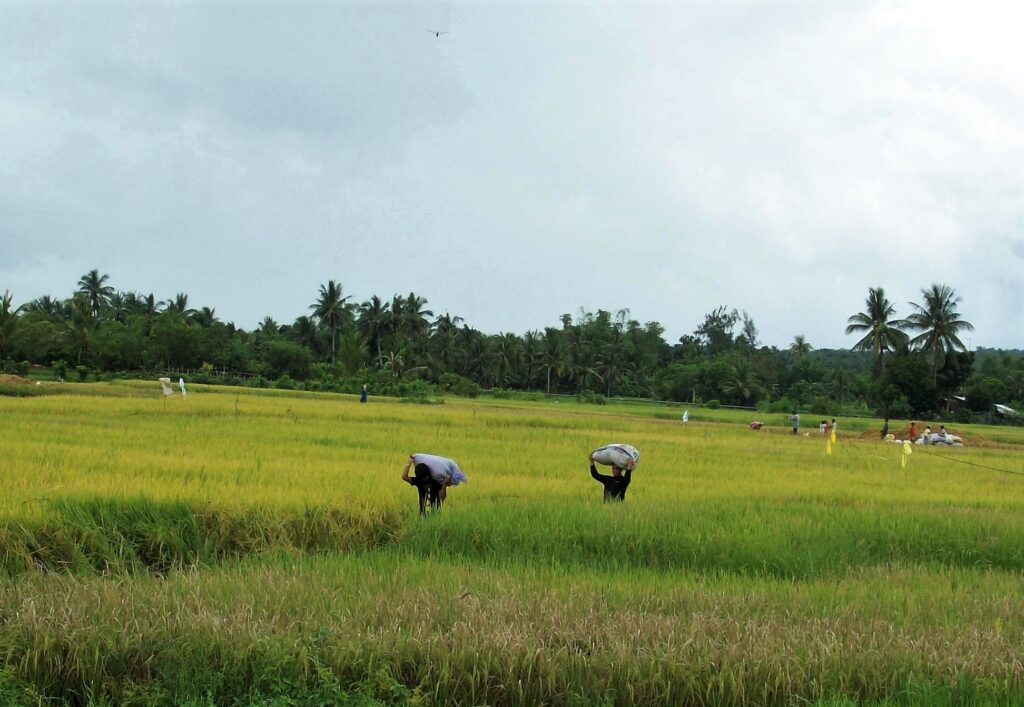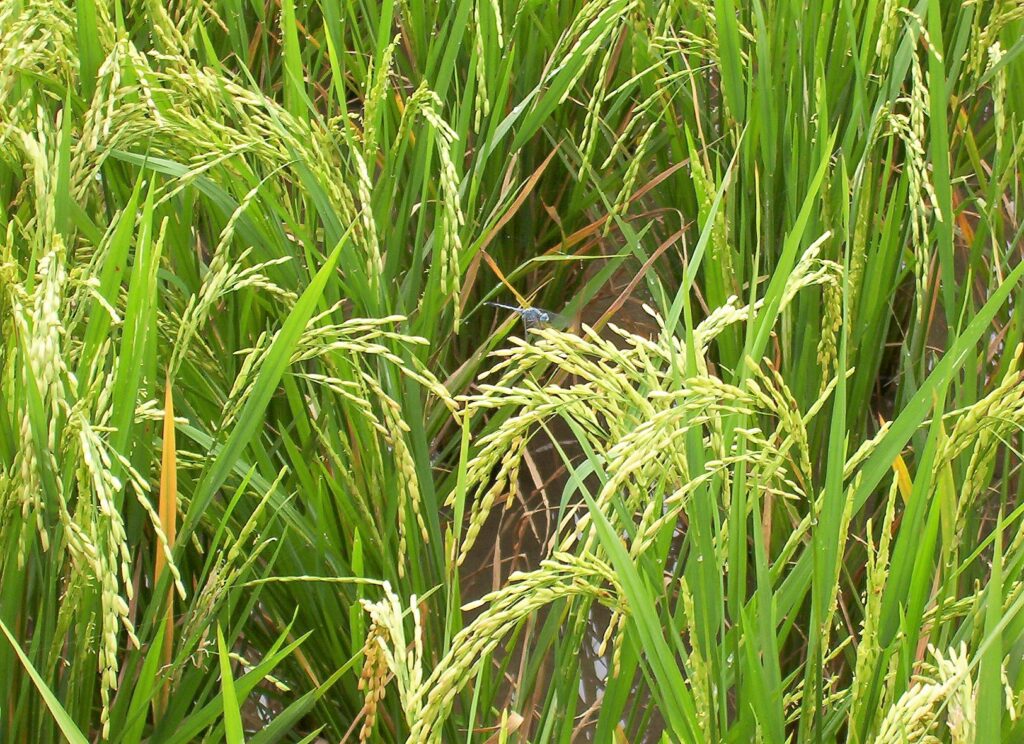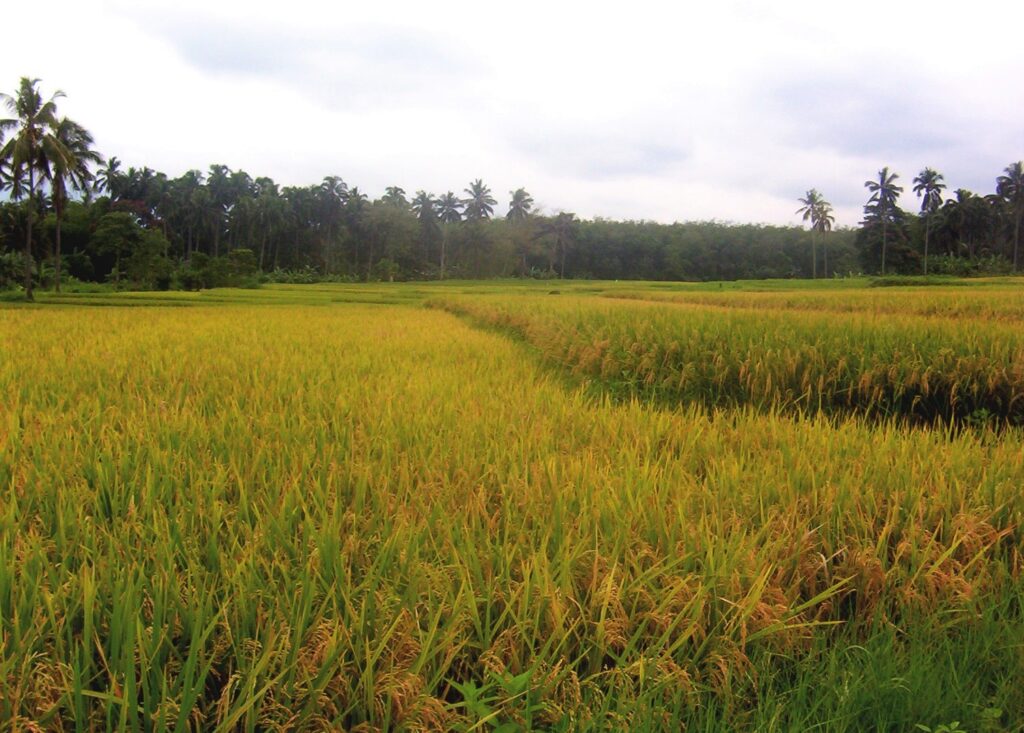Text and Photos by Henrylito D. Tacio
“Rice is the principal food for over 60% of mankind,” pointed out the Laguna-based International Rice Research Institute (IRRI). It is particularly important to Asia, where over half of the world’s population lives.
In the Philippines, rice is the staple food, together with fish. “If we did not have rice, our deepest comfort food, we would probably feel less Filipino,” the late food columnist Doreen Fernandez once said.
“One more rice, please!” This call, which rings at dinner time in all restaurants and small eateries, best sums up the eating habits of the typical Filipino to whom eating is a matter of filling up. Studies show a one-half cup of rice can furnish 82 calories of energy, enough to give someone energy to walk 26 minutes.
On average, Filipinos consume 114-120 kilograms of rice per capita per year. That’s almost double the world average of 65 kilograms per capita per year, according to Dr. Eufemio Rasco, Jr., former director of the Philippine Rice Research Institute (PhilRice).
For thousands of years, rice (known in the science world as Oryza sativa) has been part of the human diet. Historical evidence suggests that rice may have been produced and consumed up to 10,000 years ago.
“This, alongside its current global status as the world’s most important human food, makes rice production responsible for feeding more people over a longer period than any other crop,” IRRI said in a statement.
Rice production is among the most valuable source of income of Filipino farmers. In fact, one-third of the arable land – 10 million hectares – is planted to rice, Dr. Rasco said. About 2.5 million families – that’s 40% of the country’s labor force – depend on rice farming and related activities for their livelihood.
Not all rice produced, however, are eaten by Filipinos. Dr. Flordeliza Bordey, PhilRice program leader for Impact Assessment Policy Research and Advocacy, reported that every Filipino wastes 14 grams of milled rice per day, which is equivalent to about three tablespoons per person per day.
The Bureau of Agricultural Statistics reports that Filipinos spend more on rice than any other food. A survey conducted by the line agency of the Department of Agriculture showed that Filipinos, especially those from low-income households, are depending solely on rice more than ever for their daily dietary energy supply and dietary protein because it remains the most affordable food in the country.
Unknowingly, rice does not only help solve hunger but also “hidden hunger,” the colloquial term for micronutrient deficiency. It happens when people get enough macronutrients (such as carbohydrates, protein, and fat) but not enough micronutrients (vitamins and minerals) for optimum health.

Rice farming 
Rice harvesting
In rice-consuming countries like the Philippines, lack of iron, zinc, and vitamin A are prevalent micronutrient deficiencies. “The cost of these deficiencies in terms of lives and quality of life lost is enormous, and women and children are most at risk,” the Rome-based UN Food and Agriculture (FAO) said in a report.
The FAO report considered the vitamin A status in the Philippines as a “severe subclinical deficiency,” which affected children six months – 5 years (8.2%) and pregnant women (7.1%). Iron deficiency anemia is the most alarming of the micronutrient deficiencies affecting a considerable proportion of infants (56.6%), pregnant women (50.7%), lactating women (45.7%), and older male persons (49.1%).
“While reports indicate that there is enough food to feed the country, many Filipinos continue to go hungry and become malnourished due to inadequate intake of food and nutrients,” FAO noticed in its report.
In its fight against hidden hunger, IRRI and PhilRice collaborated in conducting more studies on golden rice, which has a potential way to reduce vitamin A deficiency. Golden rice is a new type of rice that contains beta carotene, which is converted to vitamin A when eaten. Rigorous research has shown that just one cup of golden rice a day could be enough to provide an adult with half their daily needs of vitamin A.
“Golden rice field trials are part of our work to see if golden rice can be a safe and effective way to reduce vitamin A deficiency in the country – to reduce malnutrition,” said Dr. Bruce Tolentino, when he was still the IRRI deputy director-general of communications. “Vitamin A deficiency is horrible and unnecessary, and we want to do our part to help to reduce it.”
Almost always, diabetics are advised to eat less rice. The reason: the starch-rich staple can potentially release high amounts of sugar into the blood when digested. The Department of Health listed diabetes as the ninth leading cause of death among Filipinos today. The country is home to four million diabetics, with more than three million not knowing they have the disease.
But Filipino diabetics may now worry less. IRRI researchers have already identified the key gene that determines the glycemic index (GI) of rice. “The GI is a measure of how a carbohydrate like starch affects blood sugar (glucose) levels,” explains Dr. Rafael D. Guerrero, an academician of the National Academy of Science and Technology. “The higher the GI, the more glucose is released by food.”
The findings of a study, which analyzed 235 types of rice from around the world, is good news because it not only means rice can be part of a healthy diet for the average consumer. It also means people with diabetes, or at risk of diabetes, can select the right rice to help maintain a healthy, low-GI diet.
“It is an important achievement that offers rice breeders the opportunity to develop varieties with different GI levels to meet consumer needs,” IRRI said in a statement. “Future development of low-GI rice would also enable food manufacturers to develop new, low-GI food products based on rice.”
Rice with low GI is, indeed, good news for Filipinos. “Low-GI rice will have a particularly important role in the diets of people who derive the bulk of their calories from rice and who cannot afford to eat rice with other foods to help keep the GI of their diet low,” IRRI said. “Low-GI rice could help to keep diabetes at bay in these communities.”
While IRRI is still trying to find the type of rice that can help those with diabetes, eating brown rice may be the best solution. A Harvard University study found out that brown rice can lower the risk of developing diabetes. Researchers drew on data from over 200,000 subjects and found that those who ate five or more servings of white rice a week had a 17 percent increased risk of developing type 2 diabetes compared with those who rarely ate white rice. What’s more, they found that those who ate brown rice regularly were overall less likely to develop diabetes.
“When we refine rice, we strip away the majority of many of the nutrients,” says Dr. Walter Willet, a co-author on the study, “including magnesium, chromium and other minerals and vitamins. You’re left with a form of starch that is rapidly broken down, leads to greater spikes in blood sugar, and increases the demand for insulin. Over time this exhausts the pancreas and leads to diabetes.”

Rice crop 
Matured rice
Filipinos eating rice is as old as rice cultivation itself. “The history of rice cultivation in the country dates back at least 3,000 years,” wrote Dr. Gelia T. Castillo, an academician, and national scientist. “The building of rice terraces came a bit later.”
However, it was in 1576 that an account of rice cultivation was recorded. By 1668, someone wrote that “rice usually does not last longer than the time it takes to harvest, since the rest they pay in tribute or sell to get the cash to pay the tribute.”
But rice is not originally from the Philippines. Until now, it is still being debated where rice originally comes from. D.H. Grist, in his book Rice, pointed this out: “We do not know the country of origin of rice, but the weight of evidence points out to the conclusion that the center of origin of rice is southeast Asia, particularly India and Indo-China, where the richest diversity of cultivated forms has been recorded.”
Cultivation of rice dates to the earliest age of man. Carbonized paddy grains and husks, estimated to date 1000 to 800 B.C., have been found in excavations at Hastinapur in Uttar Pradesh, India. Specimens of rice have been discovered in China dating from the third millennium B.C., and the Chinese term for rice appears in inscriptions from the second millennium B.C.
Paddy cultivation is of great antiquity in the Philippines. It is thought that immigrant people from southern China in the second millennium B.C. constructed the wonderful system of terraces on the mountainsides of Banaue and its neighboring areas. These people were reportedly driven into the hills by subsequent invasions of Malays.
Although the Philippines is basically an agricultural country, it has not been self-sufficient in rice. In fact, the country is currently the world’s major importer of rice. There are several reasons for this. Yield growth and production for the last two decades have been minimal, and at times even stagnated or declined, resulting in increased importation.
Unknowingly, studies have shown that there is a 75% return on investment in rice production in the country. But the fact is, there is very little room for expansion in new areas for rice.
“Most of the increase in production will have to come from increased yields/productivity,” said Simeon A. Cuyson, the executive director of CropLife Philippines, Inc. “The average rice landholding of slightly more than one hectare is uneconomic, so obviously some interventions are needed to improve efficiency, provide access to credit and marketing, and provide opportunities and the means to diversify the small farmers’ source of livelihood.”
No one knows when the world will be inhabited by 10, 15, or 20 billion people. What is clear, however, is that new technologies will be needed to produce much more rice on less land, with less labor, less water, and less pesticides. Rice production must be made sustainable as well as profitable for farmers so that they do not leave the land and join rapidly expanding, highly explosive communities of the urban poor.
As former IRRI director general Klaus Lampe puts it: “We cannot protect the environment, we cannot promote biodiversity, and we cannot provide sustainability without ensuring sufficient income earning opportunities and an adequate food supply.”

